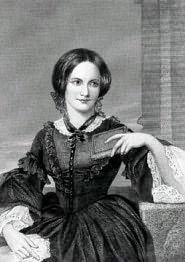Charlotte was born in Thornton, Yorkshire in 1816, the third of six children, to Maria (née Branwell) and her husband Patrick Brontë (formerly surnamed Brunty or Prunty), an Irish Anglican clergyman. In 1820 her family moved a few miles to the village of Haworth, where her father had been appointed Perpetual curate of St Michael and All Angels Church. Her mother died of cancer on 15 September 1821, leaving five daughters, Maria, Elizabeth, Charlotte, Emily, Anne and a son Branwell to be taken care of by her sister, Elizabeth Branwell.
In August 1824, Patrick Brontë sent Charlotte, Emily, Maria and Elizabeth to the Clergy Daughters' School at Cowan Bridge in Lancashire. Charlotte maintained the school's poor conditions permanently affected her health and physical development and hastened the deaths of Maria (born 1814) and Elizabeth (born 1815), who died of tuberculosis in June 1825. After the deaths of her older sisters, her father removed Charlotte and Emily from the school. Charlotte used the school as the basis for Lowood School in Jane Eyre.
Go BompaCrazy!
The Brontë children became interested in writing from an early age, initially as a game which later matured into a passion. Although they all displayed a talent for narrative, it was the younger ones whose pastime it became to develop them. At the centre of the children's creativity were twelve wooden soldiers which Patrick Brontë gave to Branwell at the beginning of June 1826. These toy soldiers instantly fired their imaginations and they spoke of them as the Young Men, and gave them names. However, it was not until December 1827 that their ideas took written form, and the imaginary African kingdom of Glass Town came into existence, followed by the Empire of Angria. Emily and Anne created Gondal, an island continuent in the North Pacific, ruled by a woman, after the departure of Charlotte in 1831. In the beginning, these stories were written in little books, the size of a matchbox, and cursorily bound with thread. The pages were filled with close, minute writing, often in capital letters without punctuation and embellished with illustrations, detailed maps, schemes, landscapes, and plans of buildings, created by the children according to their specialisations. The idea was that the books were of a size for the toys to read. The complexity of the stories matured with the children's imaginations.

Brief Biography
- Date of Birth:
- April 21, 1816
- Date of Death:
- March 31, 1855
- Place of Birth:
- Thornton, Yorkshire, England
- Place of Death:
- Haworth, West Yorkshire, England
- Education:
- Clergy Daughters' School at Cowan Bridge in Lancashire; Miss Wooler's School at Roe Head













